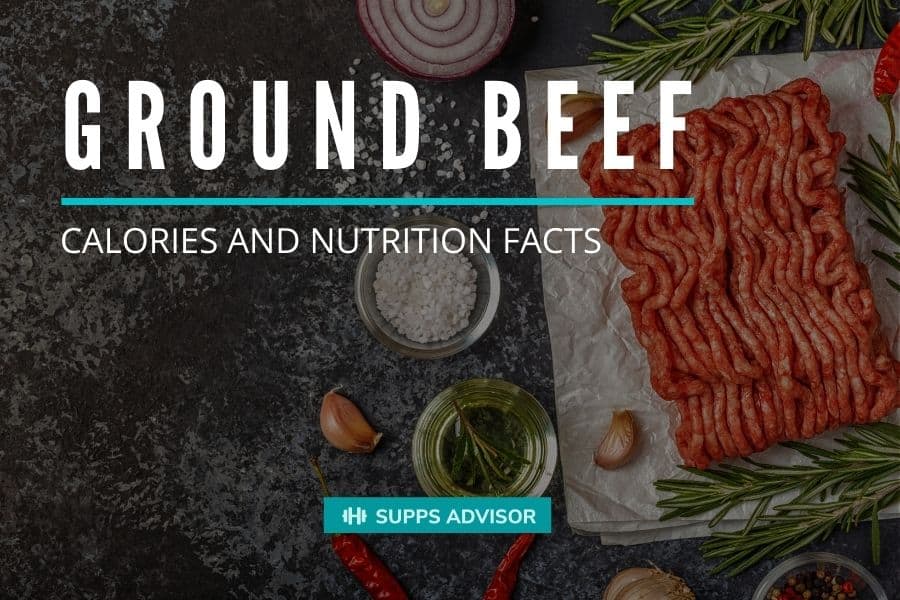When I first started exploring nutrition, hundreds of diet plans bombarded me. I had a…
TOC
Ground Beef Calories and Nutrition Facts

12/03/2020 · 5 min reading
The Benefits of Ground Beef
I have learned ground beef is a great way to ensure I have enough protein in my diet. You may not realize there are many important minerals and vitamins in ground beef. A lot of my favorite meals are made using ground beef including lasagna, meatballs and hamburgers. There is nothing like enjoying a delicious dinner that is actually healthy.
I also realize there can be a lot of unsaturated fats and calories in ground beef. If you consume too much red meat, there are potential health risks you should consider. The secret is consuming ground beef in moderation. Managing the size of your portions is also very important.

Ground Beef Nutrition Facts
I found ground beef nutrition facts from the USDA. The information below is for three ounces of 85 percent lean, cooked ground beef with no added sodium or fat browned in a pan.
- Calories: 218
- Fiber: 0g
- Sodium: 76mg
- Sugars: 0g
- Fat: 13g
- Protein: 24g
- Carbohydrates: 0g
Fats:
A lot of ground beef calories come from fat. If you cook a three-ounce serving of lean ground beef, there are 13 grams of fat. Five grams is saturated fat. According to the American Heart Association, you should limit your saturated fat consumption to between five and six percent of your daily calories. This means if you are consuming a 2,000 calorie per day diet, you can have roughly 13 grams of saturated fat.
A good example is a traditional hamburger between four and six ounces. Each burger patty you eat would have between 6.7 and 10 grams of saturated fat. Ground beef also has healthier fats such as 0.4 grams of polyunsaturated fat and six grams of monounsaturated fat. I consider hamburger calories worth every bite.
Vitamins and Minerals:
One of the best sources of zinc, iron, carnitine, selenium and B vitamins you can find is beef.
Protein:
Ground beef offers you 22 grams of protein for every three-ounce serving. This makes beef a good protein source.

Ground Beef Varieties
The fat profile for grass-fed beef seems to be healthier than meat from cattle consuming soy and corn feed. This is due to the beneficial fatty acids. Unfortunately, I have been unable to find much in the way of published research regarding the health benefits for grass-fed beef.
You can purchase ground beef in a variety of lean/fat ratios. Some beef is 97 percent lean with just three percent fat, while 70 percent lean ground beef contains 30 percent fat. You need to adjust your fat and calorie content accordingly. The information below is for three ounces of broiled ground beef and comes from the USDA.
- 97 percent lean has 130 calories, 1.9 grams of saturated fat and 3.8 grams of total fat.
- 90 percent lean has 130 calories, 3.9 grams of saturated fat and 10 grams of total fat.
- 80 percent lean has 235 calories, 5.8 grams of saturated fat and 15 grams of total fat.
- 70 percent lean has 235 calories, 6.2 grams of saturated fat and 16 grams of total fat.

Is Ground Beef Healthy?
Yes, ground beef is healthy because of the significant protein, minerals and vitamins. This helps balance out the calories in ground beef.
Boosting Your Immune System:
Beef contains numerous B vitamins including B1, B2, B3, B6, B9 and B12. These vitamins combined with the zinc in ground beef help you maintain a healthy immune system. You need to consume B vitamins because your body is unable to produce or store them.
Building Cells:
Your body requires protein for biological processes in your body. Protein helps you build muscles, skin, bones, blood and cartilage. The selenium found in beef is required for DNA synthesis.
Replenishing Iron Stores:
You are unable to make red blood cells without iron. There are two types of dietary iron, heme and non-heme. Heme comes from animal proteins including beef and is easier for your body to use.
Supporting Hormone Production:
Niacin is a B vitamin your body needs for the proper function of numerous systems such as producing sex hormones. Selenium is required for your thyroid function.
Allergies and Health Risks
You can be allergic to ground beef. If you have a meat allergy you can experience the following symptoms.
- Itchy skin
- Asthma
- Hives
- Headaches
Anaphylaxis can result in severe cases. There are tests your doctor can perform to determine if you have a meat allergy. Your physician can also help you manage your allergies. There is a link between diets including a lot of red meat and health and cardiovascular issues including a higher risk of colorectal cancer.
These risks are applicable for all kinds of red meat but become worse for processed red meats including sausages and lunch meat. Physicians recommend limiting the amount of processed and red meat in your diet.

How to Store?
Ground beef can be exposed to foodborne bacteria due to the grinding process. The recommendation of the USDA is to store your ground beef at a minimum of 40 degrees Fahrenheit. I always freeze ground beef within two days. You can destroy any harmful bacteria by cooking your ground beef to a minimum of 160 degrees Fahrenheit for the internal temperature.
You should not cook your ground beef partially because bacteria can not only survive but multiply as well. Follow safe practices when you handle food including regularly washing your hands, utensils and surfaces. Refrigerate your ground beef quickly once cooked. You can store ground beef in your refrigerator for three to four days. You can store cooked and frozen ground beef for approximately four months.

Healthy Ground Beef Recipies
You can control your ground beef calories and balance nutrition by limiting your portion size. Try combining your beef with healthy portions of grains or vegetables. You can maximize your nutrition with the recipes below.

Salad:
Make a bed containing your favorite greens and lettuce. Now add plenty of vegetables, some fruit and nuts and a little cheese. Sprinkle a little ground beef on top. I enjoy salad dressings made using canola or olive oil. You are adding healthy fats with the oils and antioxidants and volume with your vegetables.

Beef Saute:
You only need a little hot oil for both sauteing and stir-frying. You can make a delicious sautee or stir fry using three ounces of lean ground beef per person. Add all of your favorite seasonings and vegetables for a delicious meal. You add volume with vegetables and flavor with seasonings.

Hamburgers:
You can control your hamburger calories by cutting down the saturated fat. Try mixing in some lean ground turkey with your ground beef. Use a whole-grain bun and plenty of tomato slices, lettuce, pickles, sprouts and some mustard.
Final Thoughts
Ground beef has always been one of my favorite foods because there is so much I can do with it. I hope now that you are familiar with the health benefits, you will start experimenting and create your own delicious recipes. I once tried a new lasagne recipe and discovered too late I made enough for at least ten people.
The good news is my lasagna was so tasty I froze dinner size portions and really enjoyed having so many easy meals in my freezer. Now that you know all of the facts, choose your favorite recipe, start cooking and relish in making a healthy and delicious meal for your family.

Alex is a former Personal Trainer and the go-to guy when it comes to his blog - SuppsAdvisor.com. Every piece of content is thoroughly checked, rechecked, and then published by Alex!
He is very much into sports activities such as tennis, skiing, surfing and of course working out.
His motto: be active, healthy, and happy!
Related Posts
-
What Are Calories and How Are They Calculated?
-
Pre-Workout Nutrition: What Food Should I Eat Before a Workout?
While working as a personal trainer, I had a client that wasn't seeing the results…

